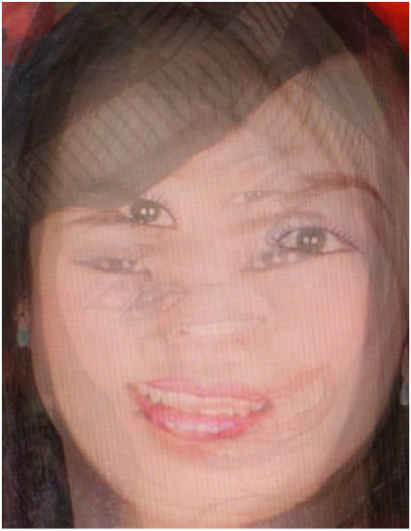The Seventh Daughter
Pao Houa Her's experimental, spare new installation work, combining sound and photographic collage, offers understated but potent commentary on the intersection of desire with notions of culture and authenticity.

When I arrive at The Bindery Projects, I think I have gotten the wrong time or location. I had arranged to meet Nate Young, co-owner of the gallery, on a Tuesday morning after Pao Houa Her’s The King’s Seven Daughters had its opening reception, but when I walk in there doesn’t seem to be any art on the walls. The gallery is completely empty, save for the leftover wine and sparkling water from the earlier night’s reception. The walls are completely blank.
“Hello?” I call. I’m frantically checking my phone to see if the Bindery Projects has relocated, or if they are, perhaps, using an outlet space for the show. Eventually, Young arrives. He says he thought we’d planned to meet the following week but that it isn’t a problem for him to turn the exhibit on for me now.
“There are just two pieces,” he says, directing me toward the visual art work while he turns on the sound piece. At first, it seems like he’s pointing at a blank section of the gallery space, but then I realize I need to walk around a temporary wall; the art is installed in a little alcove behind it. Going into that small, closet-sized space, I find a back-lit photographic image of a figure standing in a field of pink flowers. The central figure is in fact a conglomeration of numerous women, their images overlaid on each other. Stacked as they are, these various individuals merge into one: different sets of eyes and lips and noses and outfits swimming together to make a single blurry and shadowed face.
I step out of the alcove and walk back into the main gallery, where Young lets me know the sound piece is on. I prick my ears, straining to hear. There is a faint sound of young girls laughing. Young says that, for the opening, he turned the audio up a bit so people could hear, but that it’s the artist’s intention for the sound to be very low.
I listen again. The sounds are barely audible.
“We knew it was risky, just doing two pieces,” Young says, but the Bindery Projects is all about experimentation. Young notes that the show is a major departure for Houa Her, whom he met when they were both Jerome grantees last year. The title recalls Hmong folklore, he says — a story about a king with seven daughters, each one has a particular trait that makes them desirable to men. The youngest daughter, endowed as she is with a combination of all her sisters’ gifts, is the most desirable of them all. Young explains that Houa Her, who was born in Laos and moved to Minnesota with her family in 1986, has used appropriated images of Hmong women from an international Hmong dating site to create the visual piece. This dating site mostly pairs Hmong-American men with Hmong women still living in Laos, although there are some Hmong men from Laos in the mix as well.
It strikes me that there are a couple of separate currents running through the exhibit. On the one hand, you have the installation itself, where both the image and the sound comment on notions of ideal femininity within Hmong culture, especially in the context of diaspora. With the giggling girls’ voices and the amalgamated image of women who’ve put themselves out into cyberspace to find a mate, Houa Her investigates the intersection of desire with notions of culture and authenticity. That is: for Hmong communities living in the United States or other high-income countries how are traditional and cultural notions of courtship and desirability in conflict with life in the diaspora? What prompts a Hmong-American to return to a country where they’ve never lived (or where they lived only as a young child) in order to seek a mate? Why not find a peer in the place they now call home? Houa Her illuminates how the pull of heritage, untainted by American or Western ways, still looms as an ideal. Her work also calls attention to the imbalanced power dynamics involved — between men and women, and between high-income and low income countries.
The sound component of the piece — the barely audible giggles of young girls — seems to point to a cultural preference for childlike beauty. Perhaps the particular dating site Houa Her references is “legitimate” and not used for human trafficking as other, similar sites, have proven to be. But the quietness of the voices in the audio work combined with the the tucked-away presentation of visual piece is suggestive of secrets, things hidden and possibly untoward. It strikes me that the layout of the gallery exhibition, the solitary wayfinding required to get to the work, physically references the experience of being online, at once alone with a monitor and in communication with countless, albeit virtual, others. Read that way, Houa Her’s work gives a sense of what it is to live in this digital age, when screens and smartphones supercede in-person interactions and we’re caught between limitless connection and loneliness. Like the king’s youngest daughter, Houa Her’s collaged figure is a combination of the best of many women, but she is also no woman at all, but a monster of many faces clouded by shadows.
Related exhibition information: The King’s Seven Daughters runs from March 21 through May 9 at The Bindery Projects in St. Paul. Visits may be arranged by appointment.